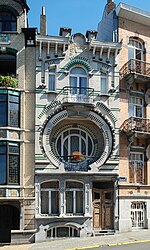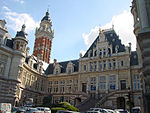Forest Park, Brussels

Forest Park (French: Parc de Forest) or Vorst Park (Dutch: Park van Vorst) is a park located in and named after the municipality of Forest in Brussels, Belgium. It was designed by Victor Besme and occupies an area of 13 hectares (32 acres).Forest Park is adjacent to Duden Park to its south, which is home to the football ground of R. Union Saint-Gilloise, the legendary football club from the neighbouring municipality of Saint-Gilles, although the club is not located in the municipality, whose border with Forest is to the north of Forest Park. The park is surrounded by a set of streets which connect Avenue Albert/Albertlaan with Avenue Wielemans Ceuppens/Wielemans Ceuppenslaan, making them part of the greater ring road. Those streets are the Avenue des Villas/Villalaan to the north, Avenue du Mont Kemmel/Kemmelberglaan to the east, Avenue Besme/Besmelaan to the south and Avenue Reine Marie-Henriette/Koningin Maria-Hendrikalaan to the southwest.
Excerpt from the Wikipedia article Forest Park, Brussels (License: CC BY-SA 3.0, Authors, Images).Forest Park, Brussels
Avenue Reine Marie-Henriette - Koningin Maria-Hendrikalaan,
Geographical coordinates (GPS) Address Nearby Places Show on map
Geographical coordinates (GPS)
| Latitude | Longitude |
|---|---|
| N 50.8225 ° | E 4.3369444444444 ° |
Address
Avenue Reine Marie-Henriette - Koningin Maria-Hendrikalaan
Avenue Reine Marie-Henriette - Koningin Maria-Hendrikalaan
1190
Belgium
Open on Google Maps









